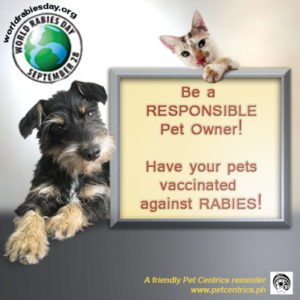World Rabies Day is an international campaign to raise awareness about the impact of rabies on humans and animals that is coordinated by the Global Alliance for Rabies Control and a United Nations Observance endorsed by various international human and veterinary health organizations.
September 28 marks the anniversary of the death of Louis Pasteur who was instrumental in the development of the first rabies vaccine.
Learn more about rabies and the status of rabies in the Philippines:
What is Rabies?
Rabies is a viral disease transmissible to both humans and animals. It is spread when saliva from an infected individual enters the body – often through a bite or scratch. Once inside the body the rabies virus infects the central nervous system leading to disease in the brain. Rabies infection is often fatal.
In humans, early symptoms include fever, headache, lethargy and discomfort. Later on, symptoms may include insomnia, anxiety, confusion, varying degrees of paralysis, excitation, hallucinations, agitation, excessive salivation, difficulty in swallowing, and fear of water.
In animals, early signs include lethargy, fever, vomiting and anorexia. This may then progress to neurological signs, weakness, paralysis, seizures, difficulty in breathing, difficulty in swallowing, excessive salivation, abnormal behavior, aggression, and self-mutilation.
Rabies in the Philippines
According to the World Health Organization, rabies is still a major public health problem in the Philippines. Hundreds of Filipinos are killed by the rabies virus each year. In many cases, victims are below age 15, and most were exposed to the virus through a bite from an infected dog.
Despite the high rabies incidence, the Bureau of Animal Industry is hoping for a rabies-free Philippines by the year 2020. They hope to achieve this by conducting mass dog vaccinations, improving diagnostic capabilities, providing more post-exposure vaccines for bite victims, and by promoting responsible pet ownership with the support of the Department of Health and local government units.
What Can Pet Owners Do?
Pet owners play a huge part in preventing the spread of rabies. Here are several ways that we can help:
1. Have your pet examined and vaccinated regularly
Every pet owner has the responsibility to maintain their pet in a healthy condition. Take your pet to regular check ups at the vet’s and have your pet regularly vaccinated against infectious diseases such as Rabies.
2. Help control stray dog and cat populations
Large stray animal populations may contribute to the likelihood of rabies being transmitted to humans because these animals are often not vaccinated. Thus, companion animals should be spayed or neutered to prevent the birth of accidental litters that have little chance of finding a good home and receiving proper health care and vaccinations.
3. Educate yourself and promote rabies awareness among your family, friends and community
Read more on rabies, learn about bite prevention and first aid, and also help promote responsible pet ownership. Be an example to your family and friends by showing how you take good care of your animals and by making sure that they are vaccinated against rabies regularly.
References:
Center for Disease Control – Rabies
http://www.cdc.gov/rabies/
Rabies in the Philippines
http://www.wpro.who.int/philippines/areas/communicable_diseases/rabies/continuation_rabies_area_page/en/index.html
Philippine Council for Health Research in the Philippines
http://www.pchrd.dost.gov.ph/index.php/2012-05-23-07-46-36/2012-05-24-00-01-11/5062-rabies-free-philippines-still-possible
Wikipedia – Rabies (Image Source)
http://en.wikipedia.org/wiki/Rabies

